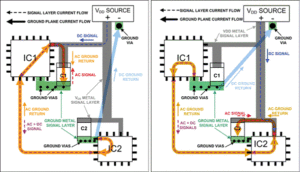Reverse Engineering Circuit Board Digital & Analog Ground
Two basic principles of electromagnetic compatibility (EMC) must be understood before Reverse Engineering Circuit Board Digital & Analog Ground: the first principle is to minimize the area of the current loop; the second principle is that the system uses only one reference plane. Conversely, if the system has two reference planes, it is possible to form a dipole antenna (Note: the size of the radiation of the small dipole antenna is proportional to the length of the line, the current flowing through it, and the frequency);
If the signal cannot be returned through the loop as small as possible, a large loop antenna may be formed. (Note: The size of the radiation of the small loop antenna is proportional to the loop area, the current flowing through the loop, and the square of the frequency. ). Both situations should be avoided as much as possible in the design.
It has been suggested to separate the digital ground and the analog ground on the mixed-signal circuit board to achieve isolation between the digital ground and the analog ground. Although this method is feasible, there are many potential problems, especially in complex large systems.

Reverse Engineering Circuit Board Digital & Analog Ground
The most critical issue in the process of Reverse Engineering Circuit Board Digital & Analog Ground is that it is not possible to route across the split gap. Once the split gap wiring is crossed, electromagnetic radiation and signal crosstalk increase dramatically. The most common problem in PCB design is the EMI problem caused by the signal line crossing the split ground or the power supply.
We use the above division method, and the signal line spans the gap between the two grounds. What is the return path of the signal current? It is assumed that the two divided grounds are connected together somewhere (usually at a certain position) Single point connection), in this case, the ground current will form a large loop.

